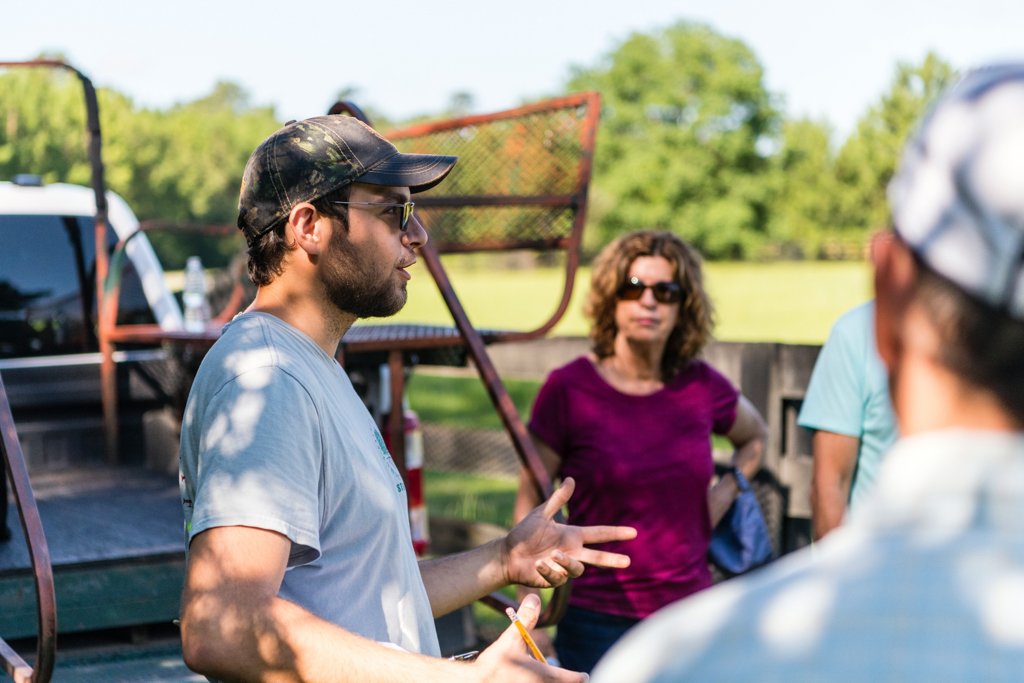Palmetto Bluff Real Estate Company Sales Office
Office Hours
Monday-Friday 9am - 5pm
Saturday 9am - 4pm
Sunday 12 - 4pm
Saturday 9am - 4pm
Sunday 12 - 4pm
The world is a new and different place. Technology has found its way into nearly every aspect of human life over the last 100 years. Seemingly every device or tool in our modern lives comes equipped with a touchscreen and internet access. In 2017, it is possible to send and receive a text message from a Wi-Fi-enabled refrigerator. There is no end to the beeping and buzzing that has become something that many people crave. It is not a stretch of the imagination to assume that the next person you interact with will check their phone at least once before your conversation is over.
As such, it becomes increasingly more difficult to detach, since many of these technological advancements have found their way into the natural world, too. Camping, hiking, hunting, fishing and nearly any other outdoor activity now have a host of electronics or apps that are required for a pleasurable experience. Technology doesn’t always come in the form of electronics, however. A short stroll through a sporting goods store can discombobulate even the most avid of outdoorsmen. Equipment is now made of incredibly expensive synthetic materials with names that don’t actually mean anything. UltraLite, Versatrack, seam-sealed poly with the connecter tek zipper configuration, flex-boil technology with fully integrated switch-lock packaging. These are some of the “advancements” and “features” one might find on otherwise simple equipment.
After you drop several thousand dollars on the basics, it is then time to go into the woods. Upon arrival, campers experience a feeling of helplessness as they attempt to set up a tent that requires an advanced degree in physics. They leave camp and head back to town for dinner because their brand new camp stove refuses to ignite. After attempting to sleep in a tent filled with materials that swish at every move, they get up, break down all of their disappointing gear, and return home to their text messaging refrigerator with an overpowering feeling of being kicked in the rear end.
Fear not! This nonsensical outlook on wilderness enjoyment is not the only way. A person armed with simple tools, some ingenuity and a few wilderness skills can delve into the natural world in a way that most never do. Bushcraft is a body of knowledge that allows this. It is the art of wilderness survival and self-reliance. Prehistoric people were experts in this field. They had to be in order to live. Early American frontiersmen learned these skills from Native Americans and were able to improve upon them with the utilization of metal tools like axes and the almighty knife. Over time and largely due to technology, life for the average person became easier, and many of these skills and techniques were forgotten. Also forgotten was the sense of pride and self-worth one feels when they have the capability to provide for themselves and make the things they need from raw materials found in the natural environment.
Though it is no longer necessary to hone one’s wilderness survival skills, much enjoyment can be taken from practicing bushcraft as a hobby. Entering the world of bushcraft is easily accomplished. It is as simple as walking outside and waiting. After a bit of time has passed, the human body will begin to need things on the most basic level. The mind of this body must then ask a tough question: how do I get the things I need like food, water and shelter? A simple kit will provide the answer.
The perfect bushcraft kit is not set in stone. In fact, it varies from person to person and is often a topic of long conversations that may evolve into friendly arguments. One may argue that another’s kit is too involved and heavy. Others may argue that a kit is too light and may not cover all the bases. One item, however, is found in all kits and is revered in the bushcrafting community. It is the belt knife. The importance of this item cannot be overstated. Processing wood, starting fires, hunting, digging, cordage production, and so many more survival basics are made possible with this tool alone. A suitable belt knife must be heavy-duty, with a fixed blade. This blade must have a full tang, which provides rigidity and durability. Also, the blade must be forged from high-carbon steel and have no coating. This allows the knife to be used in flint-and-steel methods of fire-making. It also allows the knife to hold a sharp edge and be easily sharpened when required. A bushcrafter’s skills are often judged on knife sharpness alone.
If a perfect bushcraft knife exists, it is a style known as the Kephart Knife. This American classic has a blade length of four-and-one-half inches. The handle is the same length and must be made of wood. This ensures that a new handle can be fashioned if the original is broken. (Synthetics, in all aspects of bushcraft, are frowned upon due to their lack of availability in nature.) A blade width of one inch is required to allow the blade to stand up to repeated abuse. It must also have a drop point so that skinning and processing game can be undertaken. This knife is named for the famed outdoorsman, Horace Kephart (September 8, 1862 – April 2, 1931). Horace spent most of his life in the bush, but is famed for his writing abilities and his career as a rough-and-tumble librarian at Yale University. Camping and Woodcraft: A Handbook for Vacation Campers and for Travelers in the Wilderness is his finest work. It is an all-encompassing guide to the way of the bush. Our Southern Highlanders is another one of his books that sums up his time living among the “hillbillies” of the Great Smoky Mountains during the early 1900s. If anyone is responsible for keeping bushcraft alive through the development of modern society, it is this man.%GALLERY%Back to the kit previously mentioned. There are several other items that find their way into the packs of the average bushcrafter. An ax/tomahawk/hatchet is one of these items. Much like the knife, there are endless varieties of these tools, and each has its own merit. A heavy-felling ax is good for processing large logs into lumber. The tomahawk is optimal for use as a hunting weapon. The most popular, however, is the hatchet. The hatchet is a hybrid of an ax and a tomahawk. No matter which variety is chosen, a wooden handle is a requirement so that another may be fashioned if the first ever fails. Sturdy woods are required for handle-making as they will receive repetitive, high energy impacts. As with baseball bats, hickory and ash are the best fit for the job at hand.
There should also be a variety of ways to start a fire. Fire has countless uses in bushcrafting. Other than the obvious benefits of warmth, cooking and boiling water for consumption, it acts as a morale booster, which can prove to be almost as valuable. The steady, flickering light of a fire can provide companionship, and it has an almost hypnotic effect that leads to good ol’ fashioned relaxation. There’s nothing like a quiet night by a campfire. This mellowing of the mind will be welcomed because building fire with primitive techniques can sometimes prove to be challenging. Within the bushcraft realm, predominant methods of starting a fire include using the bow drill, flint and steel or ferrocerium rods. Yes, a regular Bic lighter will save you some time, but where is the fun in that? After all, the whole point of this hobby is to leave behind the conveniences of home and push the limits of what one can devise.
Several other items are acceptable but not required. Cordage of some kind is always worth its weight. Paracord, or 550 cord, is very strong for its size. It is also cheap and easy to get your hands on. It can be found at the nearest Walmart in a variety of colors and lengths. Tarred nylon rope or string is also exceptionally handy. This type of rope is much better than paracord when it comes to knots. The tar coating also forms a weatherproof seal, and the string will last much longer than paracord.
A stainless steel cup or pot will certainly earn its keep within the kit. Stainless steel is optimal because it is lightweight, rust-resistant and works nicely over an open flame. This cup or pot will serve as a vessel to boil water when fresh spring water cannot be found. It is good practice to always boil water before consumption in order to kill harmful bacteria. The cup is also the kitchen in the bush. It is where meals can be cooked and enjoyed. There are countless bush recipes that can tickle the fancy of the most enthusiastic food connoisseur. There are, however, many meals that will not. Bushcraft as a hobby can afford one the leisure to go home and have dinner. Bushcraft as a way to survive will often lead to a soup du jour containing whatever nature made available on that particular day. Further discussion on this topic can be left to the imagination. Processing sustenance is not the cup’s only use. It can also be used to process medicines, oils, waxes and many other things from plant materials.
Wool blankets are a wonderful addition. True wool will hold in body heat even when wet. It is also flame-resistant and durable. Seek a blanket that is long enough for the entire body and wide enough to lay on half and cover the body with the other half. This will form a human taco of sorts. This blanket can also be folded in half several times to form a pad to sit on while working or relaxing. Aside from comfort, a wool blanket can also be used to form a satchel to carry all of the other necessities.
The kit, as important as it may be, is useless without the skills to put it to work. Learning to properly wield and maintain tools is as valuable as the tool itself. Just as in most hobbies, reading and practice are required for mastery. Reading, however, is useless without practice and vice versa. Think of the average man. He often attempts to build things without reading the instructions. He only refers to the instructions after he is completely frustrated with the project at hand. Going into bushcraft with this mindset will not work. A plethora of literature is available for reference. After learning about the skills necessary for the bush, one can then go out and practice. Some recommended literature includes the previously mentioned works of Horace Kephart. In addition, Dave Canterbury has written three books that pertain to bushcraft. Bushcraft 101, Advanced Bushcraft and The Bushcraft Field Guide to Trapping, Gathering, and Cooking are all exceptional reference material. Canterbury’s and Kephart’s works cover much of the same ground. In fact, most publications on bushcraft have very similar subject matter, but different points of view are always valuable.
The deeper one looks into the world of bushcraft, the more one will begin to notice that no two bushmen are the same. Each has their own quirks and preferences. This differentiation in knowledge and skill is the reason many refer to bushcraft as the art of survival; it truly is an art. Begin looking at the different tools, furniture, shelters, traps and clothing people make from their trusty knife and things collected from the natural world, and it becomes perfectly obvious that there is beauty and uniqueness here. Bushcraft can be frustratingly hard work, but what it gives back is priceless: accomplishment, confidence and feeling of full immersion in the outdoors. There are very few hobbies, skill sets or bodies of knowledge that can provide so much from so very little.
Side bar:
The Conservancy shares many of the same values found in bushcraft. Appreciation for nature, historical skills our ancestors developed, and hard work can be found in both entities. Over the years, the Conservancy has hosted “Girls Gone Wild,” a wilderness survival class geared toward the women on Palmetto Bluff. These events are wildly popular, and the Conservancy intends to expand on this in 2017 with a variety of survival and bushcraft classes. Keep an eye open for opportunities.
Written by Justin Hardy

Palmetto Bluff’s Moreland Village feels a world away from the more traditional architecture of the iconi...

We are thrilled to introduce the inaugural winners of the Inspiring the Arts Scholarship—three extraordinary young women pursuing their artistic dreams through higher education! Katherine Donahue has been named our first official scholarship recipient, wit...

From handmade jewelry to performance wear, the latest arrivals at Palmetto Bluff’s retail spots capture the season in true Lowcountry style. This summer, the Bluff’s shops are full of fresh finds, carefully chosen by our trusted retailers—including FLOW Galler...

Citizen Science is Thriving at Palmetto BluffDid you know that residents of Palmetto Bluff are playing a vital role in national and global conservation efforts—all from their backyard?Through the Palmetto Bluff Conservancy’s growing Citizen Science programs, c...

In October 2024, Grammy Award-winning musician Clay Ross visited Palmetto Bluff as part of The Arts Initiative's Artist in Residence Program. Through storytelling and song, he explores identity, heritage, and the universal language of sound. By Barry Kaufman ...

Palmetto Bluff Club Executive Chef Beth Cosgrove and Director of Culinary, Chef Rhy Waddington, Cook Up Four Peachy Recipes for a Summer in the South. Is there anything more iconic than a southern peach? A symbol of summer and Southern heritage, the peach car...

Following the tides and angling for redfish in Lowcountry creeks and estuaries with Captains Brian Vaughn and Will Stephens Story by Sandy Lang It is a sunny morning in October and the water is calm and glassy. The silence is punctuated by a gush of breath f...

7 Ways To Upkeep Your Palmetto Bluff Home As spring arrives in the Lowcountry, the change in season brings more than blooming marshlands and sun-drenched afternoons; it’s also a perfect time to refresh and care for your Palmetto Bluff home. Coastal living mea...

When the land speaks, you listen. And at Palmetto Bluff, it spoke to two of golf’s most legendary course designers—Bill Coore and Ben Crenshaw. We invite you to watch our newest video, shot this past winter and featuring Bill and Ben, along with South Street P...

5 Renovations to Increase the Value of Your Lowcountry Home Whether Palmetto Bluff is your full-time residence or a cherished retreat, deciding to sell is never a quick or casual choice. However, when the time does come, you want your home to be as market-rea...
Learn about the Palmetto Bluff Conservancy and how we keep the vision of our land in place.
On land or water, there is an ever-evolving variety of activities.
We do not attempt to independently verify the currency, completeness, accuracy or authenticity of the data contained herein. All area measurements and calculations are approximate and should be independently verified. Data may be subject to transcription and transmission errors. Accordingly, the data is provided on an “as is” “as available” basis only and may not reflect all real estate activity in the market”. © [2023] REsides, Inc. All rights reserved. Certain information contained herein is derived from information, which is the licensed property of, and copyrighted by, REsides, Inc.